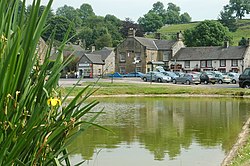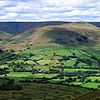Hartington, Derbyshire
| Hartington | ||
|---|---|---|
Shire county | ||
| Region | ||
| Country | England | |
| Sovereign state | United Kingdom | |
| Post town | BUXTON | |
| Postcode district | SK17 | |
| Dialling code | 01298 | |
| Police | Derbyshire | |
| Fire | Derbyshire | |
| Ambulance | East Midlands | |
| UK Parliament | ||

Hartington is a village in the centre of the
Architecture
Notable buildings in the village include the market hall (formerly the site of a
Near Hartington is the finest
Hartington Mill, now a private house, stands by the River Dove. This was the local water mill for grinding corn.
Attractions
The village has a
A little south of the village, overlooking the Dove, stands
Three miles (5 km) to the south-west of the village lies the small settlement of Hulme End; this marks the northern starting point of the Manifold Way, an 8-mile (13 km) tarmacked walking and cycling route that follows the route of the former Leek and Manifold Valley Light Railway.
History
According to the
Railway
Hartington railway station, on the Cromford and High Peak Railway, was opened in 1899; it was sited on the part of the line that ran from Buxton to Ashbourne. Regular passenger services ceased in 1954, due to low passenger numbers, and the line through Hartington was lifted in 1964.
Much of the line has since been converted to a shared-use path called the Tissington Trail. Hartington signal box has been retained and is now used as an information centre.
Cheese
The creamery in the village, often called the cheese factory, was founded by the
Notable residents
- Marie Litton, English actress and theatre manager, was born here in 1847
- James F. Redfern, sculptor, was born here in 1838
- Steve Sutton, former Nottingham Forest F.C. goalkeeper, was born here in 1961
- John Oliver, British-Canadian politician and premier of British Columbia, was born here in 1856.
See also
References
- ^ "Hartington Town Quarter civil parish population 2011". Neighbourhood Statistics. Office for National Statistics. Retrieved 25 March 2016.
- ^ Walking Britain website
- ^ English Place Name Society database at Nottingham University
- ISBN 0-14-143994-7p.745
- ^ Vision of Britain site
- ^ About Derbyshire website
- ^ "End of era as 150 jobs go at Hartington dairy". Buxton Advertiser. 18 March 2009. Retrieved 8 February 2014.
- ^ This Is Business Staffordshire Nov 2009
- ^ "Made in the Peak District - traditional Stilton is back on the shelves". Buxton Advertiser. 13 September 2014. Retrieved 6 October 2020.

